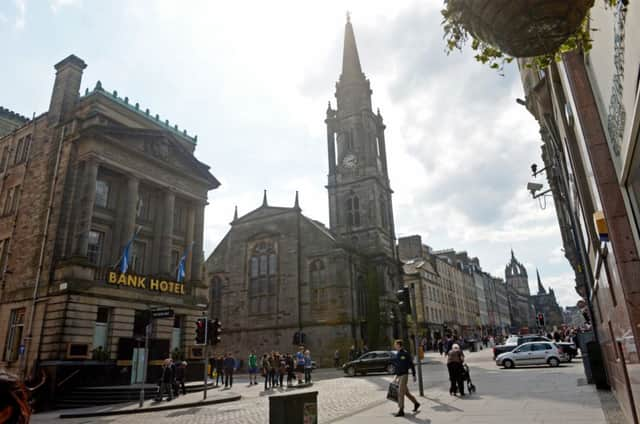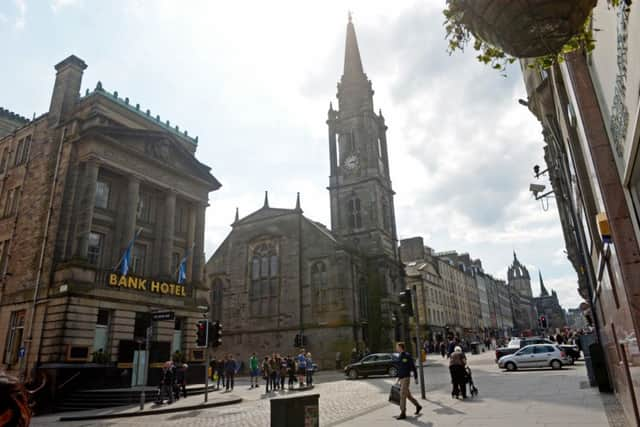Edinburgh Video Guide: Royal Mile


The thoroughfare, as the name suggests, is approximately one Scots mile long and runs downhill between two significant locations in the history of Scotland, namely Edinburgh Castle and Holyrood Palace. The streets which make up the Royal Mile are (west to east) Castlehill, the Lawnmarket, the High Street, the Canongate and Abbey Strand. The Royal Mile is the busiest tourist street in the Old Town, rivalled only by Princes Street in the New Town.
The Castle Esplanade was laid out as a parade ground, in 1753, using spoil from the building of the Royal Exchange (now the City Chambers). It was formalised in 1816 when it was widened and provided with decorative railings and walls. The Esplanade with its several monuments has been A-listed by Historic Scotland. It is the venue of the annual Edinburgh Military Tattoo at which time specially designed temporary grandstands are erected. Cannonball House is notable for a cannonball lodged in the wall, often said to have been accidentally fired from the Castle but which actually marks the elevation of Comiston springs, three miles to the south of the Castle, which fed a cistern on Castlehill, one of the first piped water supplies in Scotland.
Advertisement
Hide AdFrom the Castle Esplanade, the short section of road entitled Castlehill is dominated by the former Tolbooth-Highland-St John’s Church (on the south side at the foot of this section), now the headquarters of the Edinburgh International Festival society - The Hub, and on the north side by the Outlook Tower and Camera Obscura. The Assembly Hall of the Church of Scotland and New College are further down on the same side, in an architecturally somewhat understated building as seen from this side. The Scottish Parliament met in the Assembly Hall between 1999 and 2004.


The Lawnmarket was originally part of the High Street before its separate naming, which accounts for the street numbering being a continuation of the High Street numbers. A charter of 1477 designated this part of the High Street as the market-place for what was called “inland merchandise” - items such as yarn, stockings, coarse cloth and other similar articles. In later years, linen was the main product sold.
Parliament Square
On the south side, about one-third of the way down from the Castle toward the Palace is Parliament Square, named after the old Parliament House which housed both the law courts and the old Parliament of Scotland between the 1630s and 1707 (when its existence was ended by the Act of Union) Parliament House now houses the Court of Session, Scotland’s supreme civil court. St Giles’ Cathedral, the High Kirk of Edinburgh, also stands in Parliament Square.
By the West Door of St Giles’ is the Heart of Midlothian, a heart-shaped pattern built into the setted road, marking the site of the Old Tolbooth, formerly the centre of administration, taxation and justice in the burgh. The prison was described by Sir Walter Scott as the “Heart of Midlothian”, and soon after demolition the city fathers marked the site with a heart mosaic. Locals have traditionally spat upon the heart (aiming very specifically for its centre), presumably to express disgust. The custom has been to some extent sanitised by tourist guides who claim that the spitting is merely for good luck. On the north side, opposite St Giles’, stand Edinburgh City Chambers, where the City of Edinburgh Council meets. On the south side, just past the High Kirk, is the Mercat Cross from which royal proclamations are read and the summoning of Parliament announced.
The whole south side of buildings from St Giles to the Tron Kirk had to be rebuilt or refaced in the 1820s following the Great Edinburgh Fire of 1824. This was done in a very simple but well-proportioned Georgian style, stepping down the hill.
North Bridge
The central focus of the Royal Mile is a major intersection with the Bridges. North Bridge runs north over Waverley station to the New Town’s Princes Street. South Bridge (which appears at street level to be simply a road with shops on either side—only one arch is visible from below) spans the Cowgate to the south, a street in a hollow below, and continues as Nicolson Street past the Old College building of the University of Edinburgh.
Advertisement
Hide AdAt John Knox’s House the High Street narrows to a section of the street formerly known as the Netherbow, which, at its crossroads with Jeffrey Street (north) and St Mary’s Street (south), marked the former city boundary. At this point stood the Netherbow Port, a fortified gateway between Edinburgh and the Canongate (until 1856 a separate burgh), which was removed in 1764 to improve traffic flow. The recently rebuilt Netherbow Theatre is owned by the Church of Scotland and houses the Scottish Storytelling Centre. Following the English victory over the Scots at the Battle of Flodden in 1513, a city wall was built around Edinburgh known as the Flodden Wall, some parts of which survive. The Netherbow Port was a gateway in this wall and brass studs in the road mark its former position. On the corner of St Mary’s Street is the World’s End Pub which takes its name from the adjacent World’s End Close, whimsically so named because this was in former times the last close in Edinburgh before entering the Canongate.
Beyond the crossroads, the Royal Mile continues down the Canongate, meaning literally “the canons’ way” when it was used in former times by the Augustinian canons of Holyrood Abbey. The street continues downhill past Moray House (now the main academic offices of Moray House School of Education of the University of Edinburgh), the old Canongate Tolbooth (now a museum of social history called The People’s Story), the Kirk of the Canongate (the Canongate’s parish church and a thriving congregation of the Church of Scotland) and the new Scottish Parliament Building to Holyrood Palace and the ruined abbey. Until 1856 the Canongate was not merely a street, but the name of the surrounding burgh, separate from Edinburgh and outside the Flodden Wall.
• The above video was supplied by Rury Mason of Edinburgh Video Guide